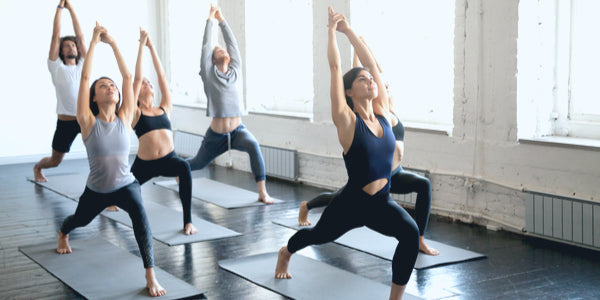
Yoga has a long history, though it continues to be practiced in modern day. What's more, the benefits of yoga are invaluable and supportive of both physical and mental health.
But the art of yoga is much more than a collective group of flowing movements. There are different styles considered to be gentle or more challenging than others.
With so many types of yoga, how do you know which style is best for you? Find out the different types of yoga and their benefits here!
The Different Types of Yoga
From gentle to challenging yoga types, learn about common yoga styles and which may be the best fit for you.
Hatha Yoga
Hatha yoga is essentially the basic fundamentals of yoga - including the attention on breath, meditation and postures. Though it is a generally broad category, Hatha tends to be gentle and slow.
Hatha class may be the most beneficial to gain insight of common terms and movements if new to yoga.
Kundalini Yoga
With Kundalini yoga, there is less physical demand with a deeper spiritual development. The yoga style incorporates movement, dynamic breathing techniques, mediation, and the chanting and singing of mantras.
Kundalini may be right for you if seeking out a livelier yoga practice.
Iyengar Yoga
Iyengar offers both equal parts of body strengthening movements and peace of mind. It primarily focuses attention to details including the alignment of body postures and precision.
Poses are held for longer periods of time in Iyengar yoga. Props are also used, including belts and blocks, to further accommodate and teach a proper posture.
Iyengar classes may be a good practice for yogis interested in strengthening alignment in a slower-paced environment.
Sivananda Yoga
Coined after the original presenter by Swami Sivananda, this style of yoga is more of a holistic approach. It focuses on the entire body, while concentrating more on relaxation and breathing.
Sivananda encourages a vegetarian diet and positive thinking as well. So if desiring a complete yogic lifestyle, Sivananda may be the perfect fit!
Dru Yoga
Dru yoga is "a graceful and potent form of yoga, based on flowing movements, directed breathing and visualisation." It is promoted for all fitness levels and age groups.
Though it continues to promote body flexibility and strengthening, it further deepens connections to whole-body health and happiness.
Bikram Yoga
Also known as hot yoga, Bikram yoga is a series of yoga poses and techniques in a heated environment.
Though beginner courses are available, the heat may not be enjoyable to all individuals and poses as a challenge. For this reason, Bikram yoga is encouraged at the yogi's own discretion.
Ashtanga Yoga
Ashtanga is a more structured form of yoga and promoted to build core strength and tone the body. It extends on standard yoga poses and is recommended to those who want to be challenged.
The yoga postures and movements of Ashtanga do require more coordination and strength than other yoga types. However, practitioners of Ashtanga can move at their own pace given their experience level.
Truly, Ashtanga yoga includes more vigorous abilities. Since this style of yoga is physically demanding, be prepared to sweat!
Vinyasa Yoga
Vinyasa is a type of yoga that moves fluidly from one posture to the next. There is also an emphasis of breath as yogis flow through the sequence.
Various poses during each vinyasa class makes this yoga unpredictable, thus reducing the risk of burnout and dropout of its supporters.
Power Yoga
Power yoga is a type of fitness yoga and often confused with Vinyasa and Ashtanga yogas. While they do have similarities, power yoga is more juiced up version with less focus on common meditative principles.
If looking to break a sweat and away from standard workout classes, Power Yoga may be the right fit!
Try On Yoga Styles for Size
When deciding on which yoga is right for you, try identifying the desire for its undertaking. If wanting a physical challenge, Ashtanga may be a better fit rather than a slower-paced Iyengar-style.
But do not be afraid to explore all yoga classes and types, either. This list is concise and there are other styles worth exploring. Besides, you never know until you try and yoga is proven beneficial to health!
10 Physical and Mental Benefits of Yoga
From reducing depression to supporting heart health, the benefits of yoga extend to physical, mental, and emotional health.
1. Yoga for Depression
Yoga has shown to improve personal scores of well-being and depression. The reduction of stress responses that follow yoga practices can contribute to lower levels of depression. Controlled breathing techniques can further provide depression relief as well.
2. Yoga for Anxiety & Mood
The calmness, relaxation, and fluidity of yoga has consistently shown to reduce stress and anxiety by regulating stress responses. The natural anxiety relief from yoga may help alleviate panic attacks, or at least dissipate overwhelming emotions.
Research has also found a new connection between yoga and mood. A group of healthy individuals practiced one-hour yoga sessions, three times per week, over a 12-week long period. In addition to reporting lower feelings of anxiety and greater improvements in mood, the yoga-goers increased their GABA levels. Low levels of GABA may be linked to anxiety and mood disorders.
3. Yoga for Sleep
Inadequate sleep can be caused by a number of factors, stress and anxiety included. But with a quiet mind and deeper relaxation, followers of yoga may be able to improve their sleep cycles.
Studies have shown yoga can increase overall quality of life, including on mood and sleep, in patients with dementia and cancer.
4. Yoga & Focus
Yoga-goers can improve brain function with each yoga pose. Certain yoga techniques have been used to stimulate the brain and nervous system.
According to a CBS News report, even doing just as little as 20 minutes of yoga may boost brain power. More specifically, people improved reaction times and accuracy on tests 20-minute yoga session. This was not shown in those who participated in a 20-minute aerobic exercise activity.
5. Yoga for Self-Esteem
The psychological effects of performing yoga postures shows to improve sense of energy and self-esteem. What's more, the positive effects of yoga practice can occur after performing yoga poses for only 2 minutes.
Displaying and improving self-esteem and confidence reflects in all facets of life. This includes on personal attitudes and beliefs and how they influence the way we think, create, and nourish the body.
6. Yoga for Brain Disorders
Yoga may be a beneficial add-on therapy for brain disorders and mental health conditions. Research particularly shows positive effects on schizophrenia and post-traumatic stress disorder (PTSD).
Schizophrenia is a severe, chronic brain disorder in which individuals may experience delusions, confusion, personality loss, and bizarre behavior. The condition cannot be cured but can be controlled with lifelong treatment. This generally includes a combination of medication, counseling, and potentially yoga.
PTSD follows shocking and terrifying life experiences. The condition may trigger flashbacks, nightmares, and anxiety for months and years after or potentially lifelong. Experts suggest yoga may be a beneficial supplement to treatment programs.
7. Yoga for Strength
Although building muscle is not a primary focus or goal of yoga, its use can certainly facilitate strength.
Whether or not yoga should be implemented as a sole strength training regimen certainly aligns with individual goals. However, the practice can be effective for sculpting lean body mass.
8. Yoga for Heart Health
Pranayamas are breathing exercises practiced in yoga. Implementing and refining these breathing techniques improves breathing and posture, thus increasing lung capacity. Large air volume and flow offers fresh oxygen into the lungs and body tissues.
Yoga has been shown to contribute to improved heart health in a series of ways. First off, yoga manages and reduces stress, a risk factor for high blood pressure and heart disease. Yoga also contributes to the recommended 150 minutes of physical activity each week for good heart health. Individuals who enroll in yoga sessions are shown to continue exercising further down the road.
9. Yoga Effects on Weight Loss
Though yoga is slow and tame, research has shown yoga can lead to weight loss.
Experts commonly suggest increased mindfulness and awareness may facilitate better lifestyle choices, including healthier and more nutritious food selections.
10. Yoga for Injury Protection and Recovery
Athletes of all sports turn to yoga to avoid injury or recover from one. Poses and motions help to increase flexibility and stretch out tense muscles.
Yoga can restore body and muscle functions rather than break them down the way an intense workout can.







